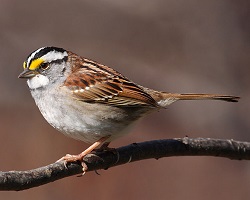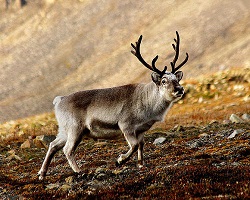
Animals of the Boreal Forest
If you walk through the Canadian taiga in early April, you may encounter a bizarre phenomenon on the forest floor. At first, you may think that someone just left a pile of shiny, twisted dark ropes on the ground. Upon closer look, you realize that not only is this pile wriggling, but it composed of many slender heads and tails.
Congratulations! You have stumbled upon a knot of red-sided garter snakes. This phenomenon occurs when warming temperatures wake garter snakes from hibernation. Males first emerge from their dens and wait. Once a female slithers out, the males jump on her all while wrestling each other to try to mate with the female.
If you come back to the same spot in the middle of the winter, you will only find a blanket of snow on the ground. In fact, it may be difficult to find any wildlife in the taiga at all in the winter. A snowshoe hare may dart past you as it sprints from a pack of hungry wolves. At night, the hoot of a Great-gray owl may echo through the dark forest. In general, however, the winter of the taiga is quiet and lonely.
Sleeping Beauties

Most year-round residents of the taiga are inactive through the harshest winter months. A few of them sleep through most of it. Once the temperatures start dropping, these animals first eat as much as they can to store thick layers of body fat. Then, they look for dark, quiet places. Terrestrial (land) animals such as chipmunks and garter snakes will find burrows underground, and semi-aquatic animals like snapping turtles will burrow into the muddy bottom of ponds.
In certain mammals, their body temperatures will drop to help them save energy over the winter. Bears in the taiga also bulk up and sleep through the winter, but the body temperature of bears does not drop enough for their sleep to be considered true hibernation. When these year-round taiga residents are sleeping, they do not eat. Luckily, they have a lot of body fat to keep them from going hungry. The arrival of spring and warming temperatures stir these hibernating animals from their slumbers. It takes a lot of energy to wake up, though, and these animals burn through the last of their stored body fat to wake up and greet the sun.
Noisy Summer Visitors

Some animals, especially certain birds, can't handle the year-round taiga experience. On one hand, these birds love the warm and moist taiga summer, especially with the blooming insect populations. On the other hand, they can't deal with the winter. To solve this problem, birds such as the Siberian Thrush and White-Throated Sparrow spend their winters in the south. They migrate north so that they arrive in the taiga bogs just in time for the warm weather and the swelling clouds of mosquitoes, dragonflies, and moths.
The swampy grounds erupt with the mating calls of these migratory birds when they pause from eating to seek partners. Before long, eggs begin hatching and baby birds start to demand for food. Bird parents stuff regurgitated insects and seeds into the mouths of their offspring so that their young can quickly grow before the short taiga summer ends. If something happens to the nest and baby birds, there is not time to start over again. Once temperatures begin to cool down, these migratory birds pack up and move back south.
Winter Champions
Not all animals leave before the taiga winter. Some animals, like the Siberian tiger, the snowshoe hare, and the snow goose not only live in the taiga for the entire year, but also remain awake through the winter.

To survive, these animals have special adaptations like large paws to maneuver through the snow and thick coats to protect against the bitter cold. Snowshoe hares lose their summer brown coat and grow one in winter white to help them blend into the winter landscape.
Fish that live in the lakes and ponds of the taiga have little choice over whether or not to spend the winter in the boreal forest. When temperatures drop below freezing, the surface of the lake freezes over. Luckily, because ice is lighter than water, ice remains on the surface. Fish like northern pike and Alaska blackfish live under the ice at near-freezing temperatures.
Images via Wikimedia Commons. Wolves by Vargar.
Janet Storey's wood frog image: Ask A Biologist tries to ensure proper permissions before posting items on this website. For this image we have not been able to reach the copyright owner. If you have information regarding the copyright owner, please contact Ask A Biologist using the feedback link in the gold box to the right.
Read more about: Trailing Through Taiga
Bibliographic details:
- Article: Animals of the Taiga
- Author(s): Dr. Biology
- Publisher: Arizona State University School of Life Sciences Ask A Biologist
- Site name: ASU - Ask A Biologist
- Date published:
- Date accessed:
- Link: https://askabiologist.asu.edu/animals-taiga
APA Style
Dr. Biology. (). Animals of the Taiga. ASU - Ask A Biologist. Retrieved from https://askabiologist.asu.edu/animals-taiga
Chicago Manual of Style
Dr. Biology. "Animals of the Taiga". ASU - Ask A Biologist. . https://askabiologist.asu.edu/animals-taiga
Dr. Biology. "Animals of the Taiga". ASU - Ask A Biologist. . ASU - Ask A Biologist, Web. https://askabiologist.asu.edu/animals-taiga
MLA 2017 Style

Many gray wolves live in the taiga, where they hunt caribou, deer, and smaller prey for food.
Be Part of
Ask A Biologist
By volunteering, or simply sending us feedback on the site. Scientists, teachers, writers, illustrators, and translators are all important to the program. If you are interested in helping with the website we have a Volunteers page to get the process started.

